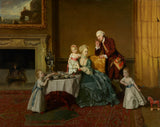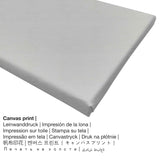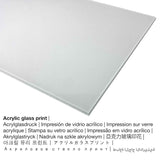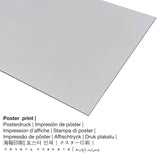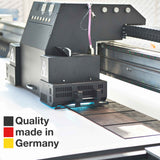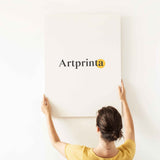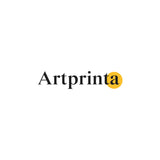Johann Zoffany, 1766 - John, Onye-nwe nke iri na anọ Willoughby de Broke, na Ezinụlọ ya - mbipụta nka mara mma.
Ụtụ gụnyere. Mbupu gbakọrọ na ndenye ọpụpụ.
Ozi zuru ezu gbasara akụkọ
Ọrụ nka John, Fourteenth Lord Willoughby de Broke, and his Family mere site Johann Zoffany in 1766. Taa, mpempe nka gụnyere na nchịkọta ihe nka dijitalụ nke Ụlọ ihe ngosi nka nke J. Paul Getty. Site n'ikike nke Ụlọ ihe ngosi nka nke J. Paul Getty (ikikere: ngalaba ọha).: . Further, the alignment is landscape and has an image ratio of 1.2: 1, nke pụtara na ogologo bụ 20% ogologo karịa obosara. The painter, printmaker Johann Zoffany was an artist, whose artistic style was mainly Rococo. The European artist was born in the year 1733 in Frankfurt am Main, Hessen state, Germany and died at the age of 77 na 1810 na London, Greater London, England, United Kingdom.
Họrọ nhọrọ ihe onwunwe gị
In the dropdown menu right next to the product offering you can pick the size and materialaccording to your individual preferences. The following sizes and materials are the options we offer you for individualization:
- Mbipụta kwaaji: The printed canvas material mounted on a wood frame. Your canvas of this work of art will let you turn your custom fine art print into a large collection piece as you know from art galleries. The great advantage of canvas prints is that they are relatively low in weight, which implies that it is quite simple to hang your Canvas print without additional wall-mounts. That is why, canvas prints are suited for any kind of wall.
- Metal (aluminium debond mbipụta): An Aluminium Dibond print is a print with a true depth effect - for a modern look and non-reflective surface. The Aluminium Dibond Print is your ideal introduction to fine reproductions with aluminum. For your Aluminium Dibond option, we print the work of art onto the surface of the white-primed aluminum. Colors are bright and vivid in the highest definition, fine details appear crisp and clear, and you can feel a matte appearance.
- Mbipụta iko acrylic (nke nwere ezigbo mkpuchi iko): A glossy acrylic glass print, often referred to as a an art print on plexiglass, transforms the original work of art into décor. Furthermore, it makes a great alternative to canvas or aluminium dibond fine art prints. The artwork is being printed with state-of-the-art UV direct print machines.
- Mbipụta akwụkwọ mmado (ihe kwaaji): Our poster is a UV printed sheet of flat canvas with a slight surface texture. Please note, that depending on the absolute size of the poster print we add a white margin between 2-6cm around the painting in order to facilitate the framing with your custom frame.
Ederede iwu: We try what we can to depict our art products as closely as possible and to exhibit them visually. At the same time, the pigments of the printing material and the print result might vary slightly from the representation on the monitor. Depending on the settings of your screen and the condition of the surface, color pigments might not be printed one hundret percent realistically. Bearing in mind that our fine art prints are printed and processed by hand, there may also be minor discrepancies in the motif's exact position and the size.
Nkọwa ngwaahịa
| Ụdị edemede: | mmepụta nka |
| Usoro mmeputakwa: | dijitalụ mmeputakwa |
| Usoro nhazi: | Mbipụta UV ozugbo (mbipụta dijitalụ) |
| Mmalite nke ngwaahịa a: | German mmepụta |
| Stockdị ngwaahịa: | a na-achọ |
| Eji ngwaahịa emebere: | foto mgbidi, ụlọ mmepụta nka nka |
| Nhazi: | nhazi odida obodo |
| Ụdị anya: | ogologo: obosara - 1.2: 1 |
| Mmetụta akụkụ: | ogologo bụ 20% ogologo karịa obosara |
| Materials: | Mbipụta kwaaji, mbipụta ọla (aluminium dibond), mbipụta akwụkwọ mmado (akwụkwọ kwaaji), mbipụta enyo acrylic (nwere ezigbo mkpuchi iko) |
| Kanvas n'elu etiti ihe ndọtị (mbipụta akwa akwa): | 60x50cm - 24x20", 120x100cm - 47x39", 180x150cm - 71x59" |
| Mbipụta iko acrylic (nwere ezigbo mkpuchi iko) dị iche iche: | 60x50cm - 24x20", 120x100cm - 47x39" |
| Mbipụta akwụkwọ mmado (akwụkwọ kwaaji): | 60x50cm - 24x20", 120x100cm - 47x39" |
| Nhọrọ mbipụta aluminom: | 60x50cm - 24x20", 120x100cm - 47x39" |
| Nhazi mbipụta nka: | biko mara na mmeputakwa a enweghi etiti |
Data ndabere na akụkụ nka pụrụ iche
| Aha nka nka: | "John, Fourteenth Lord Willoughby de Broke, and his Family" |
| Nchịkọta nke ọrụ nka: | sere |
| Nhazi nka: | nka ochie |
| Time: | 18th narị afọ |
| Emepụtara n'afọ: | 1766 |
| Afọ nka: | 250 afọ |
| Egosiputara na: | Ụlọ ihe ngosi nka nke J. Paul Getty |
| Ebe ngosi nka: | Los Angeles, California, Njikota Obodo Amerika |
| website: | www.getty.edu |
| Ikikere nke ihe osise: | ngalaba ọha |
| Site n'aka: | Ụlọ ihe ngosi nka nke J. Paul Getty |
Tebụl nyocha nke onye na-ese ihe
| Aha onye nka: | Johann Zoffany |
| Aha ndị ọzọ: | Zoffani John Joseph, Zoffanni, Zauphali, Zoffany, Zauffaly Johannes Josephus, Zaufaly, Zoffani Johan, Zauffaly Johan Joseph, Zauffaly John Joseph, Zofani, j. zoffany, Zuphaly, Zoffani Johan Joseph, Zauffely Johan Joseph, Zauffely Johan, Johann Joseph Zoffany, Zauphaly Johan, Zoffany Johan., Zoffani Johann, Zauphaly John Joseph, Zoffany John, Zauphaly Johann Joseph, Zuphali, Zoffany Johannes Josephus, Zauffely Johann, Zoffany Johann, Johan Zoffany, Zauphaly Johann, Zauffaly Johann, Zaufally, Zoffany Johann Joseph, zoffany johann, Zoffany Johan, Zoffani John, John Zoffany, zoffany j., J. Zeüffoly, Zoffani, Zauphaly Johannes Josephus, Zauphaly John, Zauffaly Johan., Zaufali, Zoffany Johan Joseph, Zauphaly Johan., Zauffaly John, Zoffany John Joseph, Zauphaly Johan Joseph, Joseph Zeufoly, Zoffani Johannes Josephus, Zoffanij Johann, Johann Zoffany, Zoffani Johan., Zoffanij, Zauffaly Johann Joseph, johann zauffely genannt john zoffany, Zoffani Johann Joseph |
| okike onye nka: | nwoke |
| Nationality: | German |
| Ọrụ: | onye na-ese ihe, onye na-ebi akwụkwọ |
| Country: | Germany |
| nhazi ọkwa: | nna ukwu ochie |
| styles: | Rococo |
| Ndụ: | 77 afọ |
| Afọ amụrụ: | 1733 |
| Amụrụ na (ebe): | Frankfurt am Main, Hessen steeti, Germany |
| Nwuru: | 1810 |
| Nwuru na (ebe): | London, Greater London, England, United Kingdom |
© echekwabara ikike nwebiisinka, Artprinta.com
Additional description from the museum (© - by The J. Paul Getty Museum - Ụlọ ihe ngosi nka nke J. Paul Getty)
John Peyto-Verney, fourteenth Lord Willoughby de Broke, and his wife, Lady Louisa North, appear about to take tea with their three young children. She holds her daughter, who stands on the table attempting a first step. In high spirits, one son enters on the right pulling a bright red toy horse. Another son attempts to take a piece of buttered bread from the table while receiving an admonishing gesture from his father. Johann Zoffany, with his ability to portray lively figures interacting together in meticulous detailed settings, excelled at conversation pieces. These informal group portraits, introduced as a new genre of painting in England in the 1700s, vividly recorded the settings and social customs of the time.
Zoffany took care to include the details of the gentry's lives: Lady Louisa's shimmering light blue gown, the landscape painting above the fireplace mantel, the fine porcelain tea service, and the reflections on the highly polished silver urn. The sparse room also makes a statement about the family's social position. Only an ancient, titled family of the British ruling class would adopt the deliberate casualness of the olive-drab walls and worn carpet. The family has nonetheless displayed its wealth in their fashionable costumes.

